Surfing Aruba: Discover the Best Spots to Catch Waves
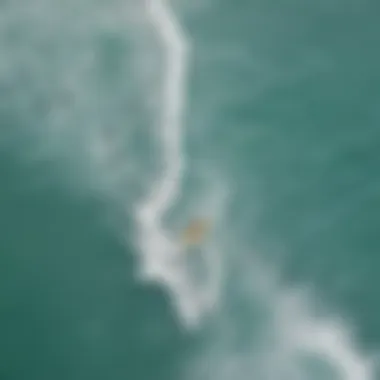
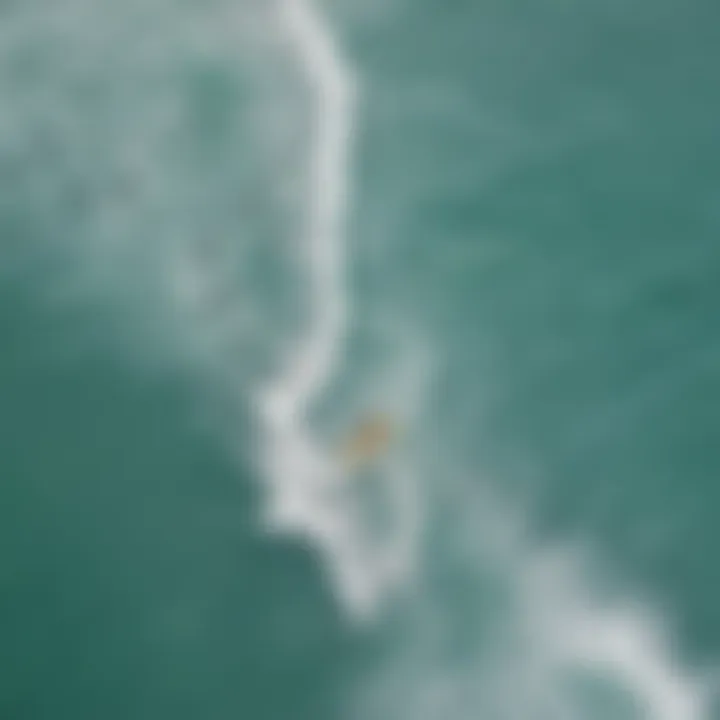
Intro
Aruba, an island that captivates with its stunning landscapes and vibrant culture, has become a mecca for surfers seeking the perfect wave. The island boasts some of the best surf spots in the Caribbean, each offering its own unique challenges and rewards. This guide seeks to illuminate the rich tapestry of Aruba's surf culture while encouraging both novices and seasoned surfers to embrace responsible surfing practices. Whether you are a beginner keen to catch your first wave or an experienced surfer in pursuit of adrenaline-pumping swells, Aruba has something for everyone. In this exploration, we will examine prime surfing locations, share essential tips, and reflect on the environmental significance of preserving these coastal treasures.
Surfboarding Techniques
Beginner Tips for Mastering the Basics
Starting out in the surfing world can feel a bit like standing on shaky ground. The key to mastering these waters lies in understanding the essentials. First, knowing how to pop up on the board is crucial.
- Start Position: Lay face down, with your toes at the tail and hands near your shoulders.
- Popping Up: Push up with your arms while dragging your toes; swiftly transition to your feet, planting them shoulder-width apart.
Practicing this motion on land can build muscle memory. Remember, patience is your ally; progress may be slow, but it is better to take baby steps than to rush into wipeouts. Finally, don't forget to observe experienced surfers and learn from their techniques.
Advanced Techniques for Seasoned Surfers
For those who have mastered the basics, Aruba offers waves that challenge even the most skilled surfers. Advanced techniques can elevate your experience:
- Carving: Use your body weight to shift between heel and toe when turning. Carving enhances your control and speed on the wave.
- Cutbacks: When you reach the shoulder, perform a cutback by turning back towards the breaking wave. This maneuver keeps you in the power zone of the wave.
- Aerials: For the daring, aerials can add flair. Approach a wave with speed, spring from the board, and land back on the wave. Each of these techniques takes time and commitment to master, but the thrill of securing that perfect ride is worth every effort.
Surfboard Equipment
Reviews of the Latest Surfboards on the Market
Choosing the right surfboard is crucial for optimizing performance on Aruba’s diverse waves. Options abound, with many designs catering to different skill levels. Popular models currently making waves include:
- Shortboards: These are great for seasoned surfers looking to perform aggressive maneuvers. Look for brands like Channel Islands and their Sweet Tooth model.
- Longboards: Ideal for cruising and beginners, Agitator Longboards offer stability and ease, perfect for learning.
- Fish Boards: For those who enjoy catching smaller, faster waves, the Rusty Fish is a crowd favorite for its agility and fun ride.
Essential Gear for Every Surfboarder
Beyond the surfboard, having the correct gear is vital for safety and enjoyment. Here are some essentials:
- Leash: Prevents your board from drifting away during a wipeout.
- Wetsuits: Depending on the season, a wetsuit may be necessary for comfort and warmth.
- Surf Wax: Ensures that your feet stick to the board, preventing slips.
- Sunglasses for Water Sports: Protect your eyes from the blazing sun while you’re out there surfing.
Important to Note
"Surfing isn’t just a sport. It’s a way of life—a connection to nature."
Responsible surfing practices must be embraced. Always practice leave-no-trace principles to protect Aruba’s pristine beaches and ecosystems. Surf responsibly, respect local surfers and the environment, and leave only footprints behind.
Understanding Aruba's Coastal Landscape
Aruba’s coastal landscape is not just a backdrop for a great day of surfing; it is the very essence of why surfers from around the globe flock here. Understanding this unique environment helps both seasoned pros and newcomers appreciate the interplay of waters, winds, and waves. It’s a complex tapestry shaped by geographical nuances and climatic conditions that directly influence surfability.
Geographical Overview of Aruba
Nestled in the southern Caribbean, Aruba is a small island that boasts a rich variety of coastlines. The northern shores meet the Atlantic Ocean, where waves crash relentlessly, creating ideal conditions for experienced surfers seeking challenging swells. Meanwhile, the southern beaches are relatively calmer, making them perfect for beginners. This diversity allows for a range of surfing experiences, from mellow rides to heart-pounding thrills.
What’s more, Aruba is dotted with numerous coves and inlets. Each spot possesses its own charm and set of conditions. Locations like Malmok Beach or Baby Beach exemplify how geography can impact wave characteristics and overall surf conditions. Surfers should take note of these geographical indicators, which can either create a perfect ride or leave them paddling against the tide.
Climate and Its Influence on Surf Conditions
The island enjoys a tropical climate that plays a crucial role in shaping the surfing experience. With temperatures typically hovering around 80°F year-round, the appeal of surfing Aruba is hard to resist. The ocean temperature usually stays in a comfy range, making wet suits optional.

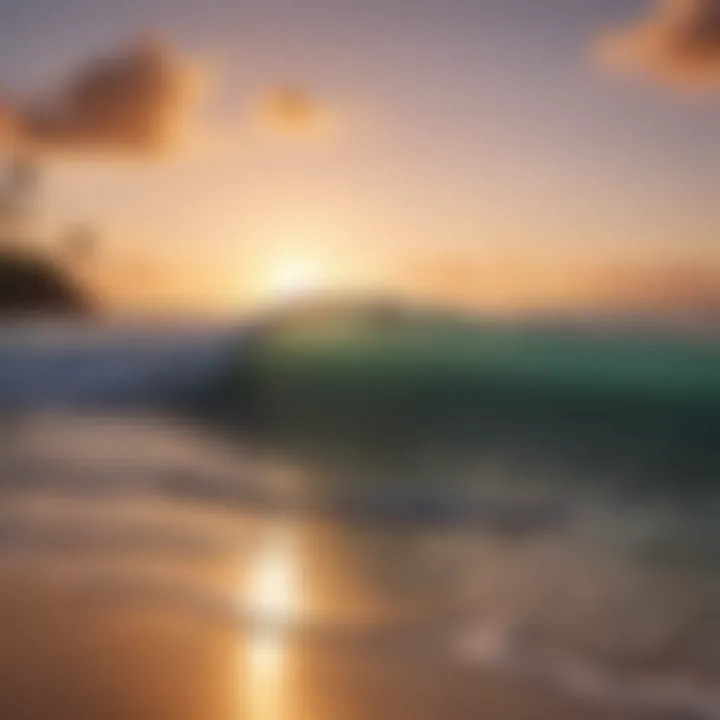
Aruba’s weather is also defined by trade winds, which can significantly affect the surf conditions. Listen closely: These winds come from the east, putting a consistent breeze on the water that tends to create clean and well-formed waves. However, the intensity of wind can vary, impacting different beaches in distinct ways. For instance, the popular Fisherman’s Huts spot is known for its wind-sheltered conditions, creating a more manageable wave pattern.
Moreover, the seasonal changes bring their own set of influences. The summer months can bring warmer water and a calmer ocean, ideal for those who are still finding their footing. Conversely, the winter months may churn up the Atlantic, providing juicier swells.
"Understanding both geographical and climatic factors is like reading the ocean's personality—surfing is just as much about nature as it is about skill."
In summary, a deep understanding of Aruba's coastal landscape not only enhances the surfing experience but also allows surfers to navigate the seas more intelligently. In essence, being aware of geographical traits and climate influences equips surfers with the knowledge to ride the best waves while soaking in the breathtaking views. This combination of elements makes Aruba a true paradise for wave enthusiasts.
Top Surf Spots in Aruba
The surf scene in Aruba is a tapestry woven with variety, each spot presenting something unique for both seasoned practitioners and those just catching their first wave. This section serves as a vital guide to the best surfing locations around the island. Whether you're a novice seeking safe swells or an expert on the hunt for adrenaline-pumping surf, understanding the highlights of these beaches is crucial. You gain insight into not only where to ride the waves but also how to navigate the local culture, the best surf conditions, and amenities. It's about diving into unforgettable experiences soaked in sun, sea, and surf.
Baby Beach: A Beginner's Haven
Baby Beach is often revered as a sanctuary for novice surfers. The water here is calmed by an extensive reef that cradles it like a protective guardian. This means the tiny waves lap gently against the shore, offering an ideal environment for the timid or inexperienced. Beginners can practice without intimidating surf conditions looming over them.
Moreover, the beach is equipped with local surf schools that offer lessons and rentals. Enthusiastic instructors help foster a love for the sport in new surfers, guiding them through the basics and ensuring comfort on the board.
- Safety: The shallow waters make it easy to stand and catch your breath, reducing the fear factor for many.
- Facility Access: Nearby amenities include restrooms and places to grab a bite, making it convenient for longer stays.
Malmok Beach: A Hidden Gem
Malmok Beach often flies under the radar, making it a hidden treasure for those in the know. The waves here vary throughout the year, accommodating different skill levels. More skilled surfers appreciate the unexpected waves that roll in, while still, the quiet atmosphere proves inviting.
Enjoy panoramic views that extend over crystal blue horizons, as you surf alongside vibrant coral reefs beneath. Upon catching your breath after a session, you can take a leisurely stroll along the shore and absorb the stunning landscapes around.
The seclusion adds an extra layer of allure, making Malmok perfect for surfers wanting to avoid the hustle and bustle of more crowded spots.
Fisherman’s Huts: The Wave Rider's Paradise
Fisherman's Huts is widely regarded as one of the premier surfing spots on the island. The name might give the impression of quaint charm, but it's the waves that draw serious surfers to this locale.
Known for its strong swells and consistent surf, this spot attracts both local and visiting surfers looking for a good challenge. It becomes a lively community as surfers share tips, tricks, and camaraderie in their aquatic playground.
True enthusiasts would rather not ride this inviting spot alone; often, several surfers can be seen paddling out together, creating a sense of community around this exhilarating experience.
Hadicurari Beach: Events and Competitions
Hadicurari Beach stands as a stage for numerous surfing events throughout the year. It’s a scene that brings both aspiring and professional surfers together in a celebration of skill. The lively atmosphere during competitions is electric, filled with cheers from fans and the excitement of competitors showcasing their talent.
Whether you're looking to participate or just want to watch and be inspired, this beach offers a delightful mix of excitement and community spirit. A comfortable beach vibe provides ample places to relax afterward, so after the thrill of competition, you can unwind while watching the sunset over the horizon.
Eagle Beach: Stunning Views and Strong Swells
Eagle Beach is not just a pretty face—while its beauty attracts sunbathers, its swells entice surfers. This beach boasts spectacular views, often cited as one of the best beaches in the world. Clear turquoise waters and soft white sands create a picturesque setting for surf sessions, no matter your skill level.
The waves can be fierce but rewarding when conditions are right, making it a favorite for intermediate and advanced surfers. Nearby, activity stalls keep the fun going by offering nearby food and drinks, making it easy to refuel after a hard day of surfing.
"The combination of nature and sport creates an experience that transcends just riding waves. Every surf session feels like touching the essence of Aruba itself."
Exploring these surf spots brings forth the diverse elements that make Aruba a captivating destination for surfers. By knowing what each location offers, surfers can make informed choices about which spots to hit according to their skill and desires. Through each encounter with the waves, a deeper relationship with the ocean and the island unfolds.
Seasonal Considerations for Surfing in Aruba
When it comes to surfing in Aruba, understanding the seasonal variations can't be overstated. Each season brings its own unique characteristics that can greatly impact wave conditions, water temperature, and overall surfing experience. For surfers, both novice and experienced, recognizing these changes is crucial for planning trips and honing skills.
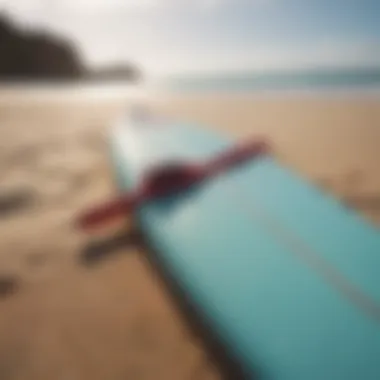
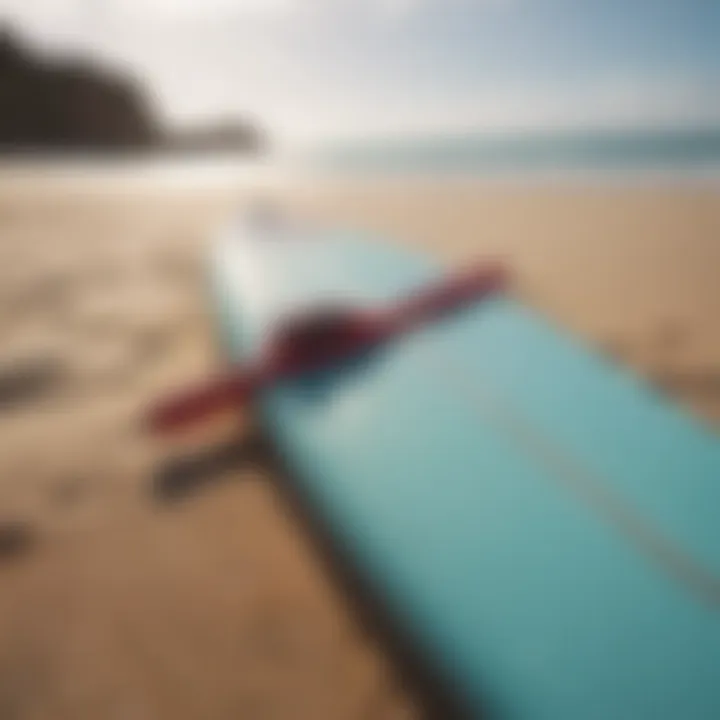
The island's geographic position means weather patterns shift in patterns that surfers should be adept at discerning. This understanding leads to better choices regarding when to hit the water, ensuring that surfers can maximize their time on the board. From the influence of storm systems in the Atlantic to the seasonal trade winds, these elements dictate surf quality and safety.
Best Time for Surfing: Month by Month
With Aruba basking in sunshine almost year-round, the calendar can easily mislead surfers into thinking that any month would be a good choice. However, paying attention to specific months can turn a good trip into a great one.
- January to March: This is considered the prime surfing season. The waves are usually stronger due to winter swells, appealing to intermediate and advanced surfers. Expect some crowding, especially at popular spots like Hadicurari Beach.
- April to June: The water temperature is pleasantly warm. This period sees a decrease in wave size, making it ideal for beginners. Less wind means smoother surfaces, perfect for learning.
- July to September: While this is typically seen as the quieter season, the waves can be inconsistent. The heat can be a challenge, too, so surfers should plan for early morning or late afternoon sessions. The trade winds pick up in September, bringing some swell, especially later in the month.
- October to December: This is hurricane season, and that can bring unpredictable weather. The waves can be mixed and sporadic. Some high-quality surf can be found, but it's a gamble. Caution is advisable during this time.
"Understanding seasonal shifts can mean the difference between a smooth ride and a disheartening wipeout."
Wind Directions and Their Impact on Surf Quality
The winds in Aruba are a surfer's best buddy, but only if understood correctly. The trade winds blow predominantly from the east-northeast, shaping the waves that kiss the shores.
- Onshore Winds: These winds blow from the water to the shore. They can create choppy surf conditions, making it tough to stay balanced on the board. It can be frustrating for those seasoned in the art of surfing.
- Offshore Winds: These winds come from the land towards the sea, resulting in cleaner waves. It’s during these conditions that you’ll find some of the best surf; the waves stand tall, breaking in a rhythmic fashion. Surfers often wait for such days because they offer the potential for longer rides.
Additionally, wind conditions fluctuate with the seasons. Therefore, timing is essential. Taking a moment to check local wind forecasts can significantly elevate your surfing experience.
Understanding both seasonal cycles and wind patterns allows surfers to map out a more enjoyable surf agenda. Surfers will find themselves riding higher and more consistently, creating a deeper bond with Aruba's alluring waves.
Safety and Surfing Etiquette
When one indulges in the exhilarating sport of surfing, particularly in a stunning locale like Aruba, safety and etiquette strole hand in hand. Understanding and prioritizing these elements can shape a surfer's experience, ensuring it's both enjoyable and respectful. Both newcomers and seasoned wave riders should grasp the significance of these guidelines, as they essentially safeguard not only themselves but also fellow surfers and marine life.
Understanding Local Conditions
Aruba's coast presents a variety of surf conditions that can change dramatically based on factors like tide, wind, and weather. Before hitting the waves, it’s crucial for surfers to check surf reports, which include conditions specific to each beach. For instance, while Hadicurari Beach may be characterized by its consistent waves ideal for intermediate surfers, Baby Beach hosts gentler swells suited for novices. Familiarizing oneself with these local quirks means recognizing not just how to navigate the waters, but how to do so safely.
Surfers should also consider the impact of currents and local wildlife. Rip currents can catch even the most seasoned surfers off guard. A strong current can draw swimmers away from the shore, making it paramount to stay alert. A rule of thumb is to never turn your back to the ocean and to quickly learn how to recognize signs of changing conditions.
Additionally, becomes important to understand local fauna. While Aruba boasts beautiful marine life, the possibility of encounters with sea creatures like jellyfish can’t be brushed aside. A little caution goes a long way; wearing a rash guard not only protects against sunburn but may also offer a layer of protection against minor stings.
Respecting Other Surfers: The Unwritten Rules
Surfing, often regarded as a ritual of sorts, has its own set of unwritten rules that surfers need to adhere to. These unspoken codes not only foster a sense of community but also prevent conflicts in the lineup. First and foremost, there’s the concept of right of way. A surfer closest to the peak of the wave has priority, and it's courteous to allow them to ride without interference. This may seem basic, but adherence to it helps maintain order in the water.
Moreover, maintaining a respectful attitude in the lineup is key. Avoid loud discussions or displays of aggression if someone inadvertently cuts in. A simple wave or a nod can go a long way in showing you're all about good vibes.
Surfers are often encouraged to greet each other, maybe with a casual “hello” or a friendly smile. These small acts can foster camaraderie and promote a positive environment in the surf community. Additionally, if a situation arises where disputes occur, consider addressing it calmly and privately instead of escalating any tension.
In summary, practicing safety and etiquette in Aruba's surfing scene not only enhances your experience but also cultivates a spirit of respect for the ocean and fellow enthusiasts.
"In the ocean, as in life, it’s the unseen currents that often steer our course. Respect the waves, respect each other.”
By balancing a respect for local conditions and showing consideration for your fellow surfers, you can truly immerse yourself in the vibrant surf culture that Aruba has to offer.
Surf Gear: Essential Equipment for Aruba
When it comes to catching waves in Aruba, having the right surf gear can make all the difference between an exhilarating experience and a frustrating one. There's a certain charm in the turquoise waters and warm sun, but the waves can be as tricky as navigating a maze. Thus, understanding what equipment you need to bring or rent is crucial, whether you're a weekend warrior or a seasoned pro.
Key Elements of Surf Gear
Every surfer knows that the right board is as essential as your own two feet. Choosing equipment that suits your surfing style and skill level not only enhances performance but also ensures safety. Having a solid setup allows you to focus on the ride instead of fiddling with your gear.
Choosing the Right Board for Aruba's Waves
Different surf spots around Aruba offer varying wave types and conditions, and having the appropriate board is vital for maximizing the surf experience.
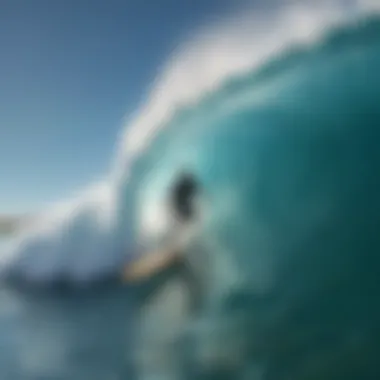
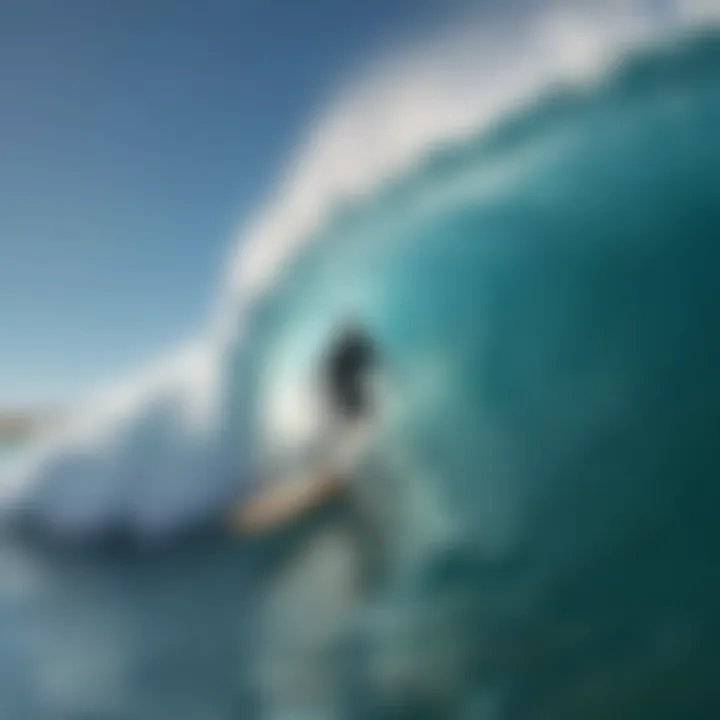
- Shortboards: If you're looking for something nimble and quick, shortboards typically excel in steeper waves like those at Malmok Beach. They allow for sharper turns and quicker maneuvers, lending themselves well to surfers seeking adrenaline. However, they require more skill and balance.
- Longboards: For those who might not feel ready to tackle aggressive waves, longboards are a go-to option. They provide greater stability and are ideal for the beginner surfer, especially at spots like Baby Beach where the waves are milder.
- Fish and Funboards: These hybrids bridge the gap between shortboards and longboards. With their wider profiles, they allow for more forgiving rides in varied conditions, making them suitable for both beginners and more experienced surfers.
When selecting between these types, it’s essential to consider factors such as your weight, height, and surfing proficiency. Boards that seem appealing visually may not always suit your requirements. Choosing the right length and volume influences your ability to paddle and catch waves efficiently.
Wetsuits vs No Wetsuit: A Guide
In the warm waters of Aruba, the question of whether to don a wetsuit or go without may arise, especially for surfers used to colder climates. Here's a useful breakdown:
- No Wetsuit:
- Wetsuit:
- Most of the time, you can surf in just your board shorts or swimsuit. The tropical climate keeps the water temperature comfortable throughout the year, reducing the need for a wetsuit.
- Pros: Greater freedom of movement, lighter feel, and typically less hassle when changing after the session.
- Some surfers will opt for a shorty wetsuit, especially during the high winds of winter months or if staying in the water for extended periods.
- Pros: Extra buoyancy can aid paddling, and protection from potential jellyfish stings or sunburn is an added benefit.
In the end, the choice often leans towards personal comfort and local conditions. Best to chat with local surfers or instructors to gauge what others are wearing based on the day's circumstances.
"Having the right gear not only uplifts your surfing experience but also fosters a tighter bond with the ocean."
Understanding the equipment landscape is just as important as knowing how to ride the waves themselves. Gear might seem like a small part of your journey, yet it deeply influences your overall performance and enjoyment of the vibrant surf scene in Aruba.
Environmental Considerations in Surfing
Surfing is not just about riding the waves; it's about connecting with the ocean and the environment. In Aruba, where the coasts are pristine and the marine life is vibrant, understanding environmental considerations is crucial. These elements serve not only the local ecosystems but also the surfers who seek to enjoy the natural beauty of the island. Protecting the environment ensures that surfing remains a sustainable and enriching experience, making awareness of these considerations all the more pivotal.
Sustainable Practices for Surfers
Being a surfer comes with a responsibility. It’s vital to adopt sustainable practices to minimize the impact on Aruba's delicate coastal areas. Here are some essential tips:
- Clean Up After Yourself: Always pick up trash or any other waste after a surf session. Even small pieces of plastic can harm marine life.
- Use Eco-Friendly Products: Many companies now produce biodegradable waxes, reef-safe sunscreens, and other sustainable surf gear. Opting for these products can help reduce pollution.
- Respect Wildlife: Keep a safe distance from marine animals, particularly during nesting seasons or where sensitive habitats are present. This practice helps maintain the natural balance in the waters.
- Carpool: When heading to surf spots, try sharing rides with fellow surfers. This reduces carbon emissions and gets you vibing with others in the surfing community.
By implementing these simple habits, surfers can play a significant role in preserving the beauty of Aruba's surf spots and the ecosystem.
Conservation Efforts in Aruba's Marine Ecosystem
Aruba has established various conservation programs aimed at safeguarding its marine environment, which directly benefits surfers. Some key initiatives include:
- Reserves and Protected Areas: The Aruba Marine Park is an excellent example. It protects coral reefs and diverse species, ensuring vibrant underwater life for future generations of surfers and divers.
- Educational Campaigns: Local surf schools and organizations often conduct workshops to raise awareness about marine conservation. These initiatives educate surfers on the significance of healthy ecosystems and encourage responsible behavior.
- Reef Restoration Projects: Efforts are underway to restore coral reefs damaged by climate change and human activities. Surfing alongside thriving reefs not only enhances the experience but also helps preserve essential habitats.
"When surfers take care of the ocean, they ensure there's a future for surfing in incredible places like Aruba."
Maintaining Aruba's marine ecosystems goes hand-in-hand with enjoying surfing. Those who surf here have the chance to protect the vibrant environment while experiencing it firsthand. Without conscious effort, these beautiful locations could be lost, and thus ensuring their protection is paramount—both for the thrill of the surf and the health of our planet.
Epilogue: Embracing Aruba's Surf Culture
As we reflect on the vibrant surf scene in Aruba, it becomes apparent that the island is more than just a destination; it is a cultural tapestry woven together by the ocean and the passion of those who ride its waves. Surfing here encapsulates not just the thrill of catching the perfect swell but also a deeper connection to the land, people, and the ecological integrity of the marine environment. The essence of Aruba's surf culture is a blend of respect for nature, camaraderie among surfers, and appreciation for the unique beauty that each location offers.
The significance of understanding Aruba's surf culture cannot be overstated. It provides surfers, whether seasoned or novices, with a framework to navigate their experiences responsibly. Here's why embracing this culture matters:
- Preservation of Environment: Every surfer shares the responsibility of protecting the surroundings that make these adventures possible. Sustainable practices ensure that the stunning beaches and vibrant marine life persist for generations.
- Building Community: Surfing in Aruba fosters connections with locals and fellow travelers. This network often transcends age, skill level, and background, creating a welcoming atmosphere that encourages shared experiences.
- Enhancing Skills: Engaging with the local surf culture can enhance one’s skills as surfers learn from one another, sharing techniques, tips, and insights that only come from years spent on the waves.
Adopting these values helps not only in nurturing the sport but also in enriching individual experiences in the water. The collective ethos of respect for the ocean and each other contributes to a vibrant and thriving surfing community.
Future of Surfing in Aruba
Looking ahead, the future of surfing in Aruba teems with potential. As the sport continues to grow, several elements could shape its trajectory:
- Increased Arrivals: With continued marketing efforts and positive reviews, more surfers from around the globe will likely seek out Aruba. This influx can lead to more diverse perspectives in the surfing community.
- Investing in Infrastructure: Improved access to surf spots, amenities, and safety management will make the surfing experience better for everyone. Venues for competitions and events can elevate Aruba's profile on the global surfing stage.
- Youth Engagement: Introducing surfing to younger generations is vital. Schools and local organizations could facilitate programs that teach surfing while emphasizing respect for the environment.
- Sustainable Surfing Initiatives: The rising awareness of environmental issues provides an opportunity for surfers and local authorities to collaborate on sustainable practices that protect Aruba's natural beauty.
In Summary
The future of surfing in Aruba hinges on community efforts focused on sustainability, connection, and the collective joy derived from the ocean. By embracing the surf culture, every surfer can contribute to shaping a legacy that honors the island's beauty and fosters a thriving environment for future riders.















